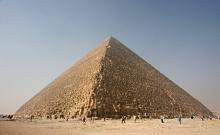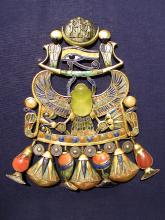Listen to today's episode of StarDate on the web the same day it airs in high-quality streaming audio without any extra ads or announcements. Choose a $8 one-month pass, or listen every day for a year for just $30.
You are here
Osiris
Orion’s Belt is one of the easiest star patterns to recognize. It’s a line of three moderately bright stars, with a slight dip at the left end. From most of the United States, it’s about half way up the southern sky as darkness falls at this time of year.
Not surprisingly, this lineup of stars has played a big role in the skylore and mythology of many cultures. In China, for example, the belt formed one of the 28 lunar mansions — the Chinese constellations.
Perhaps the most famous bit of mythology comes from ancient Egypt. There, the stars were associated with Osiris, the god of the underworld. They were considered his eternal resting place.
By the time the pyramids of Giza were built, the pharaoh was considered a god as well. When he died, he joined with Osiris in this same group of stars.
In fact, the first and largest pyramid at Giza, built by the pharaoh Khufu, appears to align with those stars. A shaft from the pyramid’s main chamber aims toward the location of Orion’s Belt at the time of construction — 4500 years ago. The shaft might have been a sort of pathway to heaven for the dead king — a way for him to unite with Osiris in the afterlife.
Some have even suggested that the pyramids were laid out in a way that mirrors the belt — although most experts disagree. Regardless of that alignment, though, there’s little doubt that the god Osiris was linked to the stars of Orion’s Belt.
We’ll have more about the belt tomorrow.
Script by Damond Benningfield




